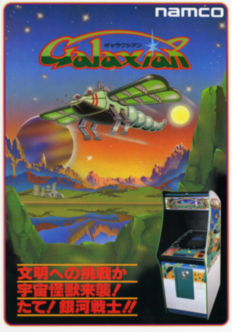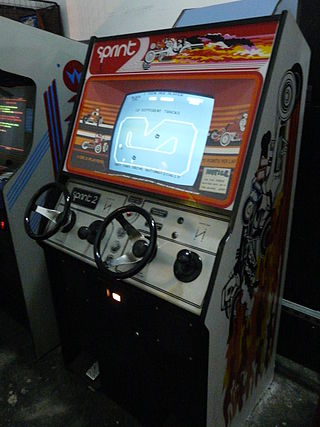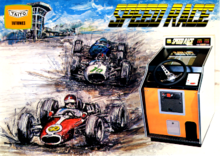Racing games are a video game genre in which the player participates in a racing competition. They may be based on anything from real-world racing leagues to fantastical settings. They are distributed along a spectrum between more realistic racing simulations and more fantastical arcade-style racing games. Kart racing games emerged in the 1990s as a popular sub-genre of the latter. Racing games may also fall under the category of sports video games.

Breakout is an arcade video game developed and published by Atari, Inc. and released on May 13, 1976. It was designed by Steve Wozniak, based on conceptualization from Nolan Bushnell and Steve Bristow who were influenced by the seminal 1972 Atari arcade game Pong. In Breakout, a layer of bricks lines the top third of the screen and the goal is to destroy them all by repeatedly bouncing a ball off a paddle into them. The arcade game was released in Japan by Namco. Breakout was a worldwide commercial success, among the top five highest-grossing arcade video games of 1976 in both the United States and Japan and then among the top three highest-grossing arcade video games of 1977 in the US and Japan. The 1978 Atari VCS port uses color graphics instead of a monochrome screen with colored overlay.

Galaxian is a 1979 fixed shooter arcade video game developed and published by Namco. The player assumes control of the Galaxip starfighter in its mission to protect Earth from waves of aliens. Gameplay involves destroying each formation of aliens, who dive down towards the player in an attempt to hit them.

Night Driver is an arcade video game developed by Atari, Inc. and released in the United States in October 1976. It's one of the earliest first-person racing video games and is commonly believed to be one of the first published video games to with real-time first-person graphics. Night Driver has a black and white display with the hood of the player's car painted on a plastic overlay. The road is rendered as scaled rectangles representing "pylons" that line the edges.

Tomohiro Nishikado is a Japanese video game developer and engineer. He is the creator of the arcade shoot 'em up game Space Invaders, released to the public in 1978 by the Taito of Japan, often credited as the first shoot 'em up and for beginning the golden age of video arcade games. Prior to Space Invaders, he also designed other earlier Taito arcade games, including the shooting electro-mechanical games Sky Fighter (1971) and Sky Fighter II, the sports video game TV Basketball in 1974, the vertical scrolling racing video game Speed Race in 1974, the multi-directional shooter Western Gun in 1975, and the first-person combat flight simulator Interceptor (1975).

Gun Fight, known as Western Gun in Japan and Europe, is a 1975 multidirectional shooter arcade game designed by Tomohiro Nishikado, and released by Taito in Japan and Europe and by Midway in North America. Based around two Old West cowboys armed with revolvers and squaring off in a duel, it was the first video game to depict human-to-human combat. The Midway version was also the first video game to use a microprocessor. The game's concept was adapted from Sega's 1969 arcade electro-mechanical game Gun Fight.
1979 saw many sequels and prequels in video games, such as Space Invaders Part II and Super Speed Race, along with new titles such as Asteroids, Football, Galaxian, Head On, Heiankyo Alien, Monaco GP, Sheriff and Warrior. For the second year in a row, the highest-grossing video game was Taito's arcade game Space Invaders and the best-selling home system was the Atari Video Computer System.
1978 saw the release of new video games such as Space Invaders. The year is considered the beginning of the golden age of arcade video games. The year's highest-grossing video game was Taito's arcade game Space Invaders, while the best-selling home system was the Atari Video Computer System.
1977 had sequels such as Super Speed Race and Datsun 280 ZZZAP as well as several new titles such as Space Wars. The year's highest-grossing arcade games were F-1 and Speed Race DX in Japan, and Sea Wolf and Sprint 2 in the United States. The year's best-selling home system was Nintendo's Color TV-Game, which was only sold in Japan.
1976 had new titles such as Road Race, Night Driver, Heavyweight Champ, Sea Wolf and Breakout. The year's highest-grossing arcade games were Namco's F-1 in Japan and Midway's Sea Wolf in the United States.
1975 had new titles such as Western Gun, Dungeon and dnd. The year's best-selling arcade game was Taito's Speed Race, released as Wheels and Wheels II in North America.
1974 had new titles such as Speed Race, Dungeon, Gran Trak 10, Tank and TV Basketball. The year's best-selling arcade game was Tank by Kee Games.

Sprint 2 is a two player overhead-view arcade racing video game released in 1976 by Kee Games, a wholly owned subsidiary of Atari, and distributed by Namco in Japan. While earlier driving games had computer-controlled cars that moved along a "canned predetermined" course, Sprint 2 "introduced the concept of a computer car that had the intelligence to drive itself around the track" in "a semi-intelligent" manner.

Sea Wolf is an arcade video game designed by Dave Nutting and released by Midway in 1976. It is a video game update of an electro-mechanical Midway game, Sea Devil, itself based on Sega's 1966 electro-mechanical arcade submarine simulator Periscope. The game was released in Japan by Taito. In Sea Wolf, the player, piloting an unseen submarine, launches torpedoes vertically in an attempt to sink ships moving horizontally across the screen before time runs out. The screen is viewed through a faux periscope mounted on the cabinet.

F-1 is a 1976 electro-mechanical arcade racing game developed and published by Nakamura Manufacturing Company (Namco), and distributed in North America by Atari, Inc. The player uses a steering wheel to control a Formula One racer, which must avoid collision with other vehicles. The game uses a miniature diorama with small, plastic cars to represent the player's car and opponents on a physical, rotating track, while also featuring a projector system and lighting tricks to create the illusion of racing.

Monaco GP is an arcade racing game released by Sega in November 1979 in Japan, and January 1980 worldwide. An upgraded version, Pro Monaco GP, was released later in 1980. One of the last Sega games to use TTL chips instead of a microprocessor CPU, the game has players race against a clock and pass rival racers while attempting to earn points driving through five areas.

Road Race is a 1976 car driving arcade racing video game developed and released by Sega in February 1976. Later the same year, Sega released two motorbike racing variants, Man T.T. and Moto-Cross, which were in turn re-branded as Fonz, in November 1976. The game was based on the character Fonzie from the 1970s TV show Happy Days, with the slogan being "TV's hottest name, Your hottest game." Sega licensed Fonz because at the time it was owned by Charles Bluhdorn's Gulf+Western Company and it was a Paramount Television intellectual property.
Electro-mechanical games are types of arcade games that operate on a combination of some electronic circuitry and mechanical actions from the player to move items contained within the game's cabinet. Some of these were early light gun games using light-sensitive sensors on targets to register hits, while others were simulation games such as driving games, combat flight simulators and sports games. EM games were popular in amusement arcades from the late 1940s up until the 1970s, serving as alternatives to pinball machines, which had been stigmatized as games of chance during that period. EM games lost popularity in the 1970s, as arcade video games had emerged to replace them in addition to newer pinball machines designed as games of skill.

LeMans is a single-player race game created by Atari, Inc. in 1976. It was distributed in Japan by Namco. It is the successor to the Gran Trak 10 and Gran Track 20 video games.











